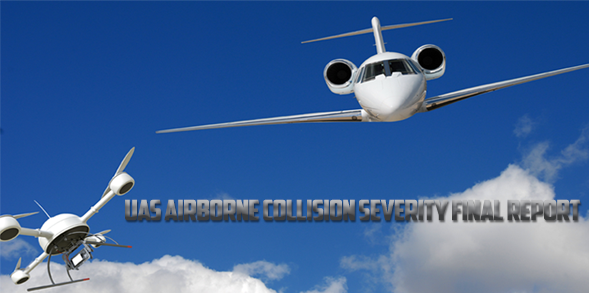On November 28th the FAA announced the release of a report by the Alliance for System Safety of UAS through Research, aka ASSURE. This report was commissioned in 2015 to test the potential damage to manned aircraft due to mid-air collisions with drones and how that compared to the more traditional airborne hazard: bird strike. The report concludes that drones which collide with manned aircraft can cause more structural damage than birds of the same weight for a given impact speed.
The FAA will use the research results to help develop operational and collision risk mitigation requirements for drones. ASSURE conducted its research with two different types of drones on two types of aircraft through computer modeling and physical validation testing.Unlike the soft mass and tissue of birds, most drones are made of more rigid materials. Testing showed that the stiffest components of the drone – such as the motor, battery and payload – can cause the most damage. Concentrating those masses on the drone can also cause greater damage, the researchers found.The research team evaluated the potential impacts of a 2.7-lb. quadcopter and 4 lb. quadcopter; and a 4-lb. and 8-lb. fixed wing drone on a single-aisle commercial transport jet and a business jet. They examined impacts to the wing leading edge, the windshield, and the vertical and horizontal stabilizers. The windshields generally sustained the least damage and the horizontal stabilizers suffered the most serious damage.The structural damage severity levels ranged from no damage to failure of the primary structure and penetration of the drone into the airframe. However, the research specifically did not explore the risk to flight imposed by that damage. The researchers concluded that unmanned aircraft system manufacturers should adopt “detect and avoid” or “geo-fencing” capabilities to reduce the probability of collisions with other aircraft.The team conducted a preliminary computer simulation to evaluate the potential damage to engine components if a drone is ingested into an aircraft engine, including damage to fan blades, the nacelle and the nosecone. They plan future additional research on engine ingestion in collaboration with engine manufacturers, as well as additional airborne collision studies with helicopters and general aviation aircraft.Even though the findings seemed to corroborate what most people suspected, that drones are more dangerous than birds for aircraft in flight, manned aviation has shared the sky with our feather friends for a hundred years and accidents where human life is lost are few and far between. Birds have self-preservation mechanisms that in most cases allow the mid-air collision to be avoided, and that’s exactly what the detect-and-avoid systems bring to the table. Being able to utilize a series of technologies that would allow UAVs to get out of the way of other flying aircraft in the critical consideration here.That’s why it’s so important that while we wait for every drone to be equipped with this detect-and-avoid technology, drone pilots stay away from airports and follow the rules to avoid any potential encounter with a manned flying machine.Subscribe
The information you submit will be stored and used to communicate with you about your interest in Commercial UAV News. To understand more about how we use and store information, please refer to our privacy policy.
December 1, 2017
FAA Releases Study on Potential Mid-air Drone Collisions















Comments